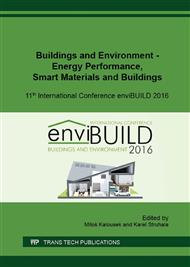[1]
P. Gomathi, A. Sivakumar, Accelerated curing effects on the mechanical performance of cold bonded and sintered fly ash aggregate concrete, Constr. Build. Mater. 77 (2015) p.276–287.
DOI: 10.1016/j.conbuildmat.2014.12.108
Google Scholar
[2]
E. Güneyisi, M. Gesoglu, Ö. Pürsünlü, K. Mermerdas, Durability aspect of concretes composed of cold bonded and sintered fly ash lightweight aggregates, Compos. Part. B-Eng. 53 (2013) p.258–266.
DOI: 10.1016/j.compositesb.2013.04.070
Google Scholar
[3]
T. Yiu Lo, H. Cui, S. A. Memon, T. Noguchi, Manufacturing of sintered lightweight aggregate using high-carbon fly ash and its effect on the mechanical properties and microstructure of concrete, J. Clean. Prod. 112 (2016) p.753–762.
DOI: 10.1016/j.jclepro.2015.07.001
Google Scholar
[4]
D. Farich, K. Said, The use of coarse and fine crushed bricks as aggregate in concrete, Constr. Build. Mater. 22 (2008) pp.886-893.
DOI: 10.1016/j.conbuildmat.2006.12.013
Google Scholar
[5]
P. B. Cachim, Mechanical properties of brick aggregate concrete, Constr. Build. Mater. 23 (2009) p.1292–1297.
DOI: 10.1016/j.conbuildmat.2008.07.023
Google Scholar
[6]
V. Gregorova, Lightweight Concrete Based on Recycled Foam Polystyrene and Polypropylene, In: MMK 2015. International Masaryk Conference for PH. D Students and Young Researchers, Mangnaminitas, Hradec Králové, 2015, p.2484–2489.
Google Scholar
[7]
F. Pacheco-Torgal, Y. Ding, S. Jalali, Properties and durability of concrete containing polymeric wastes (tyre rubber and polyethylene terephthalate bottles): an overview, Constr. Build. Mater. 30 (2012) p.714–724.
DOI: 10.1016/j.conbuildmat.2011.11.047
Google Scholar
[8]
Trilok Gupta, Ravi K. Sharma, Sandeep Chaudhary, Impact resistance of concrete containing waste rubber fiber and silica fume, Int. J. Impact. Eng. 83 (2015) p.76–87.
DOI: 10.1016/j.ijimpeng.2015.05.002
Google Scholar
[9]
T. Gupta et al., Impact resistance of concrete containing waste rubber fiber and silica fume, Int. J. Impact. Eng. 83 (2015) p.76–87.
DOI: 10.1016/j.ijimpeng.2015.05.002
Google Scholar
[10]
D. Bouvard, J.M. Chaix, R. Dendievel, A. Fazekas, J.M. Létang, G. Peix, D. Quenard, Characterization and simulation of microstructure and properties of EPS lightweight concrete, Cement Concrete Res. 37 (2007) p.1666–1673.
DOI: 10.1016/j.cemconres.2007.08.028
Google Scholar
[11]
A. A. Sayadi, J. V. Tapia, T. R. Neitzert, G. Ch. Clifton, Effects of expanded polystyrene (EPS) particles on fire resistance, thermal conductivity and compressive strength of foamed concrete, Constr. Build. Mater. 112 (2016) pp.716-724.
DOI: 10.1016/j.conbuildmat.2016.02.218
Google Scholar
[12]
B. Chen, J. Liu, Mechanical properties of polymer-modified concretes containing expanded polystyrene beads, Constr. Build. Mater. 21 (1) (2007) p.7–11.
DOI: 10.1016/j.conbuildmat.2005.08.001
Google Scholar
[13]
A. Kan, R. Demirboga, Effect of cement and EPS beads ratios on compressive strength and density of lightweight concrete, Indian J. Eng. Mater. S. 14 (2007) p.158–162.
Google Scholar
[14]
T. Tamut, R. Prabhu, K. Venkataramana, Partial replacement of coarse aggregates by expanded polystyrene beads in concrete, Ijreat. 3 (2) (2014) pp.238-241.
Google Scholar
[15]
Z. A. Anis Sakinah, C. T. Ratnam2, A. Luqman Chuah, and T. C. S. Yaw, Effect of Mixing Conditions on the Tensile Properties of Ethylene Vinyl Acetate/Waste Tire Dust (EVA/WTD) Blend, Polym. -Plast. Technol. 48 (2009) pp.1139-1142.
DOI: 10.1080/03602550903147270
Google Scholar
[16]
N. Dulsang, P. Kasemsiri, P. Posi, S. Hiziroglu, P. Chindaprasirt, Characterization of an environment friendly lightweight concrete containing ethyl vinyl acetate waste, Mater. Desig. 96 (2016) pp.350-356.
DOI: 10.1016/j.matdes.2016.02.037
Google Scholar
[17]
N. Dulsang, P. Chindaprasirt, P. Posi, S. Hiziroglu, P. Sutaphakdee, R. Dangsawat, P. Kasemsiri, Optimizing mix proportion of lightweight concrete containing plastic waste by Taguchi method, Adv. Mat. Res. 931-932 (2014) p.431–435.
DOI: 10.4028/www.scientific.net/amr.931-932.431
Google Scholar
[18]
P. R. Lopes Lima, M. Batista Leite, E. Quinteiro Ribeiro Santiago, Recycled lightweight concrete made from footwear industry waste and CDW, Waste Manage. 30 (2010) p.1107–1113.
DOI: 10.1016/j.wasman.2010.02.007
Google Scholar
[19]
D. Lopes, M. J. Ferreira, R. Russo, J. M. Dias, Natural and synthetic rubber/waste - Ethylene-Vinyl Acetate composites for sustainable application in the footwear industry, J. Clean. Prod. 92 (2015) p.230–236.
DOI: 10.1016/j.jclepro.2014.12.063
Google Scholar
[20]
L. Svoboda et . all, Building Materials, second ed., Jaga Group s. r. o., Praha, (2007).
Google Scholar
[21]
STN EN 206, Concrete. Specification, Performance, Production and Conformity, National Annex, Slovak Office of Standards, Metrology And Testing, Bratislava, (2015).
Google Scholar


